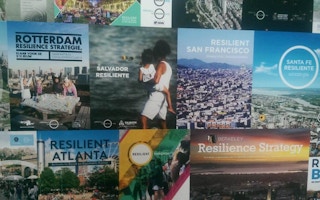In the Dutch port city of Rotterdam, nine “water plazas” have been created that soak up excess rainfall while offering people a green space to meet and children to play.
The city is also planting gardens and putting solar panels on a growing area of its nearly 20 square kilometres (8 square miles) of flat roofs.
Paris, meanwhile, is redesigning and opening green schoolyards as cooler places for locals to escape extreme heat, while in New Zealand, Wellington is rolling out neighbourhood water supplies to keep the taps on when an earthquake hits.
More than 70 cities that are part of the 100 Resilient Cities (100RC) network, set up in 2013, have crafted “resilience strategies” that include about 3,500 activities designed to combat shocks and stresses—everything from floods to an influx of refugees.
The United Nations estimates that by 2050 nearly 70 per cent of the world’s population will live in cities, which are increasingly impacted by extreme weather and sea level rise, while producing about 75 per cent of planet-warming emissions.
Michael Berkowitz, president of 100 Resilient Cities, told a gathering of the network’s cities in Rotterdam on Tuesday that efforts to build resilience had now become established as an approach to improving quality of life in cities.
Those efforts to keep people safe and well in the face of rising climate, economic and social pressures will continue, despite the closure this month of the organisation that helped them craft those plans, officials said.
At the end of July, 100RC will shut its offices after the New York-based Rockefeller Foundation said in April it would no longer fund the body, having given about $176 million for its work.
That funding helped pay initial salaries for chief resilience officers in member cities, for example, though about 80 per cent of the cities now have made the role a part of their staff, 100RC officials said.
The Rockefeller Foundation said on Monday it would provide an additional $8 million over 18 months to help 100RC cities and their chief resilience officers transition to a network they will lead themselves.
“Ultimately, we aim to ensure continued collaboration and sharing among cities to address some of their most pressing challenges,” Rockefeller Foundation President Rajiv Shah said in a statement.
Expansion ahead?
Krishna Mohan Ramachandran, chief resilience officer for the Indian city of Chennai, which has just launched its resilience strategy, said he was relieved it would be able to carry on with planned projects.
Those include conserving scarce water, putting vegetable gardens in schools, and finding less risky but nearby locations for flood-threatened communities, among others.
Rotterdam chief resilience officer Arnoud Molenaar, who led colleagues in lobbying for extra funding from the Rockefeller Foundation, said resilience work had garnered more support and created more value in cities than was often appreciated.
The Rockefeller bridge grant meant the network would now have time to raise more money from donors and others to stand on its own, and expand partnerships with politicians, communities and businesses, Molenaar said.
Elizabeth Yee, who moved from 100RC to The Rockefeller Foundation to manage its climate and resilience work, said there was a “huge” amount of money looking for resilient urban infrastructure projects, but cities often struggled to meet investor requirements.
She said a key to finding funding was to design a bus rapid transit system or a clean power plant, for example, to also create local jobs and make communities more economically secure.
“I am hopeful that we can keep helping cities develop those projects and getting them ready for bigger, broader investment,” she told the Thomson Reuters Foundation on the sidelines of the conference in Rotterdam.
Cities in the 100RC network have so far raised $25 billion from their own budgets, businesses and other sources to put their resilience plans into practice, 100RC’s Berkowitz said.
In a decade’s time, he said, he hoped urban resilience—with its holistic approach to multiple, modern-day stresses— would have become “an absolutely essential part of city government”.
For now, as cities rapidly expand and climate threats grow, much more such work will be needed, he said.
“Even 100 cities is a ridiculously small number of cities, compared to the world’s 10,000 cities,” he said.
“We need more effort if we’re going to really win the battle of the 21st century, which is going to be fought in cities.”
This story was published with permission from the Thomson Reuters Foundation, the charitable arm of Thomson Reuters, that covers humanitarian news, climate change, women’s and LGBT+ rights, human trafficking and property rights. Visit http://news.trust.org/climate.










